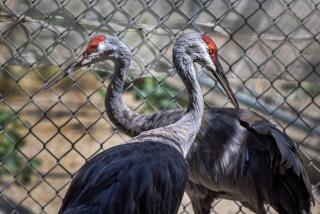Biologists’ Efforts Are Flying High as the New Day of the Condor Dawns
- Share via
VERMILION CLIFFS, Ariz. — The scene was so remarkable that even a seasoned condor tracker like Mark Vekasy was nearly moved to tears.
Eleven California condors, about one-10th of the entire population, were riding the thermals in blue skies high above northern Arizona’s dramatic red sandstone canyons on wings stretching nearly 10 feet.
It was a vision right out of history.
“They were in a real tight group just circling around. It doesn’t happen very often,” said Vekasy, part of a team of biologists who track the birds’ movements from sunup to sundown. “It’s a pretty neat sight.”
Nearly a year into a program to reintroduce North America’s largest and rarest bird to this region straddling the Arizona-Utah line, wildlife experts say it’s so far, so good.
The condors now soar solo or in small groups over carved cliffs and valleys where their ancestors once cruised for carcasses of mastodons and saber-toothed tigers.
The black-feathered giants with bald, dull-orange heads occasionally delight tourists and river rafters by floating across the Grand Canyon, which begins 30 miles south of the Vermilion Cliffs.
They’ve buzzed golfers in Page, 30 miles to the west, explored the Lake Powell shoreline and ventured nearly 200 miles into Utah, where they winged past Bryce Canyon National Park and Monument Valley before eventually returning to their base here.
“I think it’s been a great success story,” said Robert Mesta, condor program coordinator for the U.S. Fish and Wildlife Service. “They’re doing all the right things. It’s gone as good or better than I would have hoped.”
There are now 26 condors living in the wild--15 in Southern California and 11 in Arizona.
That number will grow to 40 with the scheduled releases of four more birds at the Cliffs on Nov. 20 and five birds each at Southern California’s Hopper Mountain Wildlife Refuge and along the Big Sur coastline on Nov. 10 and Dec. 7, respectively.
The initial success of the Arizona condors has buoyed hopes of one day establishing a breeding population of 150 birds in remote northern Arizona. Such a goal was unthinkable in 1987, when the species dwindled to a total of seven birds in the wild.
Thanks to captive-breeding programs at the Los Angeles Zoo, San Diego Wild Animal Park and the Peregrine Fund’s World Center for Birds of Prey in Boise, Idaho, the total condor population has swelled to 132.
In all, 15 condors have been freed in the Arizona wilderness in the last year, each equipped with a small radio transmitter so biologists from the Peregrine Fund--a conservation group assisting federal and state agencies with the reintroduction--can follow their movements.
But there have been a few setbacks in the condor experiment.
Two of the condors have died. One fractured its skull by hitting a high-tension power line, and the other died from a head wound inflicted by a golden eagle’s talons. Eagles and ravens are bitter rivals for the calf carcasses biologists set out for the condors until they learn to find the remains of mule deer, bighorn sheep and other animals on their own.
A third condor has been missing for several months and is presumed dead. Another bird was captured and placed in a zoo after construction workers fed it a road-killed jackrabbit, raising fears that other condors might observe the behavior and lose their fear of humans.
A fifth condor that became emaciated was captured and fattened at a zoo before rejoining the flock, where it is now thriving.
Wildlife officials say the mortality rate is acceptable and not unexpected.
And although the birds appear to be curious about humans, biologists are encouraged that they usually treat people like a coyote or eagle or any other large predator and fly off when approached.
“It seems like they have no interest in going into populated areas, and they’re socializing with each other so well,” said Peregrine Fund biologist Amy Nicholas. “It seems like they’re more in tune to condors and condor behavior . . . [they’re] very playful and investigative.”
Biologists also have been heartened that the condors, members of the vulture family, which eats only dead animals, have discovered carrion on their own--a key step toward self-sufficiency.
The condors are providing a boost to area tourism, attracting curious locals and serious bird-watchers from around the world. A viewing area below the Vermilion Cliffs off U.S. 89A allows the public to catch glimpses of the birds soaring or roosting shoulder-to-shoulder on rocky ledges.
“We get this huge cross-section of America--younger people, a lot of older people, people from New York City, little rural towns in Texas, people in safari gear and others in high heels and miniskirts,” Nicholas said.
Plans call for condors to be released each fall at the Vermilion Cliffs. Eventually, wildlife experts hope to reintroduce the birds to their ancestral lands in neighboring New Mexico.
Farry says it’s hard to find the right words to describe one of the prehistoric giants in flight.
More to Read
Sign up for Essential California
The most important California stories and recommendations in your inbox every morning.
You may occasionally receive promotional content from the Los Angeles Times.










